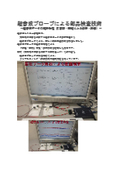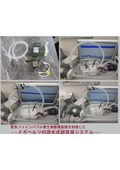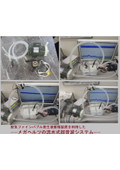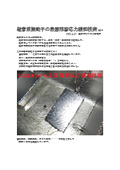Ultrasonic cleaning technology based on the measurement, analysis, and evaluation of ultrasonic propagation conditions.
The Ultrasonic System Research Institute has developed technology that applies "measurement, analysis, and control" techniques related to the nonlinearity of ultrasound to analyze and evaluate the dynamic characteristics of ultrasonic vibrations propagating through various targets (elastic bodies, liquids, gases). This technology optimizes interactions concerning cleaning objects, tools, ultrasonic transducers, water tanks, and liquid circulation according to specific purposes. Through previous oscillation, measurement, and analysis using ultrasonic oscillation control probes and ultrasonic testers, we have developed optimization technology for ultrasonic utilization by examining various relationships and response characteristics (Note: power contribution rate, impulse response, etc.). Regarding the measurement and analysis of ultrasound, the setting of sampling time utilizes original simulation technology. This technology is provided as consulting for the optimization of ultrasonic systems (cleaning, stirring, processing, etc.). The propagation characteristics of ultrasound include: 1) Detection of vibration modes (changes in autocorrelation) 2) Detection of nonlinear phenomena (changes in bispectrum) 3) Detection of response characteristics (analysis of impulse response) 4) Detection of interactions (analysis of power contribution rate)
Inquire About This Product
basic information
Countermeasures (using ultrasonic cleaning as an example) 1) Treat the ultrasonic device as a system 2) Measure the sound pressure of the ultrasonic device (vibration measurement) 3) Analyze the sound pressure data Detect issues from the propagation characteristics of vibrations 3-0) Stability Confirm the stability of the cleaning system (Check how much the sound pressure of the ultrasound, frequency, and cleaning solution changes over time, and estimate the acceptable range) 3-1) Issues with the tank Structure, strength, installation method, fixation method, ... 3-2) Cleaning solution Distribution of various factors (dissolved oxygen concentration, liquid temperature, pH, ...) 3-3) Liquid circulation Pump, microbubbles, liquid surface vibration, overflow, ... 3-4) Ultrasonic Output, frequency, control, cavitation, acoustic flow, ... 4) Confirm cleaning experiments Verify the ultrasonic conditions that have a cleaning effect (sound pressure level, main frequency, changes) 5) Organize the results of 3) and 4) Summarize improvement methods
Price information
Feel free to contact us.
Delivery Time
※Feel free to contact us.
Applications/Examples of results
Specific Examples * Water Tank Issues Modification and addition of overflow structure Change in installation method Correction of installation location (floor surface) Surface treatment of the water tank (stress relief treatment using ultrasound and microbubbles) * Cleaning Solution Addition of microbubble generation liquid circulation system Optimization of cavitation and acoustic flow based on liquid circulation setting conditions * Ultrasound Control and use of ultrasound at multiple different frequencies Change in installation method of the transducer Optimization of cavitation and acoustic flow through ON/OFF control of liquid circulation and ultrasound transducer * Cleaning Confirmation of the range of variations in cleaning conditions (cleaning items, dirt, etc.) Confirmation of cleaning objectives (cleaning level, defect rate, etc.) Confirmation of cleaning evaluation methods November 2024: Development of ultrasonic sound pressure data analysis and evaluation technology considering interaction and response characteristics December 2024: Development of nonlinear oscillation control technology for ultrasonic probes December 2024: Development of surface inspection technology based on ultrasonic propagation conditions January 2025: Development of a megahertz flow-type ultrasonic system using a degassing fine bubble generation liquid circulation device
Detailed information
-

Ultrasound probe
-

Dewatering fine bubble generation liquid circulation device used - - Megahertz flow-type ultrasonic system - -
-

Megahertz ultrasonic oscillation system
-

Nonlinear control of ultrasound (optimization of acoustic flow and cavitation)
-

Ultrasonic oscillation control technology
-

Surface modification of ultrasonic transducers (aging: relaxation of surface residual stress) treatment.
-

Deaerated fine bubble generation liquid circulation system
-

Ultrasonic combination technology
-

Ultrasonic plating treatment
catalog(21)
Download All Catalogs






News about this product(32)
Company information
The Ultrasonic System Research Institute conducts the following activities with its original product: ultrasonic systems (sound pressure measurement analysis, oscillation control): 1) Manufacturing and sales of ultrasonic systems (sound pressure measurement analysis, oscillation control) 2) Consulting services for various equipment (Note): cleaning machines, stirring devices, processing equipment, machine tools, plating devices, welding devices, etc. Ultrasonic System (Sound Pressure Measurement Analysis, Oscillation Control) We manufacture and sell a system that combines the "Ultrasonic Tester NA (recommended type)" for easy measurement and analysis of ultrasonic waves and the "Ultrasonic Oscillation System (1 MHz, 20 MHz)" for easy oscillation control. <Patent Applications Filed> Patent Application No. 2021-125866: Ultrasonic Control (Ultrasonic Oscillation Control Probe) Patent Application No. 2021-159990: Ultrasonic Welding Patent Application No. 2021-161532: Ultrasonic Plating Patent Application No. 2021-171909: Ultrasonic Processing Patent Application No. 2021-175568: Flow-type Ultrasonic Cleaning Some of the manufacturing technology for the ultrasonic oscillation control probe is described in Patent Application No. 2021-125866. Patent Application No. 2023-195514: Ultrasonic Plating Using Megahertz Ultrasonic Waves and Fine Bubbles.



















